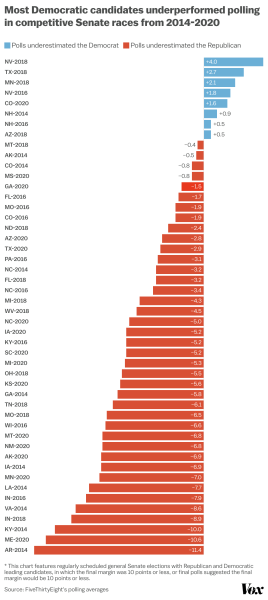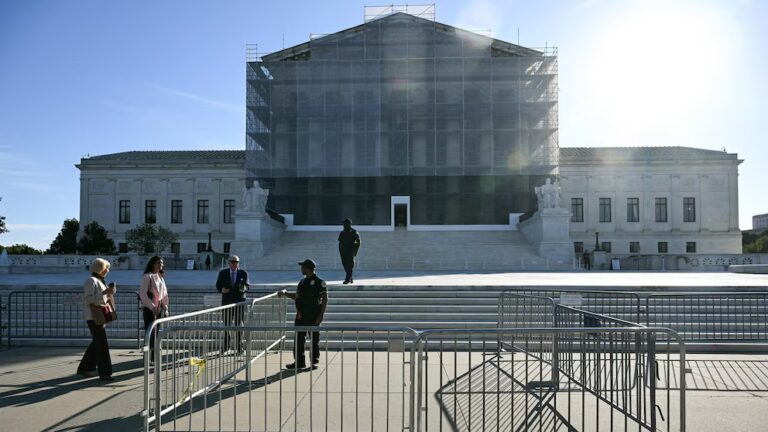
Part of The 2022 midterm elections, explained
The midterm elections are here, and all the obsessing about polling is about to run headlong into reality. Tonight, vote counting will begin, and though it may take days or longer to fully settle very close races, we will get some sense of how things look for each party on the national level.
Before that happens, though, it’s worth taking stock of the polling picture one last time. And in my view there are four important things to keep in mind.
First, the final polls look pretty good for Republicans, suggesting they’re the favorites to have a good night.
Second, polling does not show a total collapse of Democrats in key races — many contests still look close, and GOP poll leads aren’t big enough to suggest the overall outcome is a sure thing, particularly in the Senate.
Third, since Democratic majorities in each chamber are so slim, Republicans actually don’t need a red wave to gain a great deal of power — even a narrow GOP win could give Republicans control of the House and Senate.
Fourth, the final polls could well be significantly off, as they have in the past — and, since they’ve tended to underestimate Republican performance in recent cycles, a bigger red wave remains quite plausible too. Comparatively, the best plausible outcome for Democrats appears to be something close to a draw (which would be quite good by historical midterm election standards).
The state of House, Senate, and gubernatorial polls
The polling trajectory for this year’s midterms has been an odd one. Democrats started off the year expecting the worst. Then there was a period in the late summer where they started doing surprisingly well, leading to speculation that they could defy the traditional “midterms curse” for the president’s party. But in recent weeks, that Democratic optimism faded as Republicans ticked up in polls again.
Now, even in the window of relative Democratic optimism, most Democrats still assumed the House of Representatives was lost, because their party has such a small majority that a mere five districts flipping would hand the GOP the speaker’s gavel. Furthermore, several districts are near-certain to fall into Republican hands due to Democratic retirements or redistricting. Currently, Republicans have about a 1 point lead in the House of Representatives generic ballot, according to FiveThirtyEight.
A party must win 218 House seats for a majority, and the Cook Political Report assesses that 212 districts are at least leaning toward the GOP and only 187 are leaning toward Democrats (with the rest being toss-ups). Still, if Republicans do win the chamber, it isn’t clear just how big their gains will be, as the Cook Political Report’s Dave Wasserman pointed out on Twitter.
Meanwhile, in the Senate, Republicans have improved in recent polling (as compared to the late summer, when they were well behind in several key races). But polls continue to show quite a close battle. In contrast to several recent midterm cycles, no incumbent has utterly collapsed in polls, and the key races are all nearly tied.
Specifically, Senate control is likely to be determined in five key contests. Polls suggest four Democratic incumbents — Raphael Warnock in Georgia, Catherine Cortez Masto in Nevada, Mark Kelly in Arizona, and Maggie Hassan in New Hampshire — face tight races. And one Republican-held open seat could flip in the race pitting John Fetterman against Mehmet Oz. (There could be surprising outcomes in other Senate races, but these currently look the closest in polls.)
Since each party currently holds 50 Senate seats, Republicans only need to pick up one seat on net to get a majority. That means defeating one Democratic incumbent — or, if Fetterman triumphs, two incumbents. Currently, the FiveThirtyEight polling averages show:
- Narrow Republican leads (about 1 percentage point each) in Georgia and Nevada.
- Narrow Democratic leads (about 2 percentage points each) in Arizona and New Hampshire.
- A near-tied contest in Pennsylvania (Oz led by 0.5 percentage points on Tuesday morning).
That is a very close contest. The polling picture does suggest an edge for Republicans, since there are more Democratic-held seats at risk in these close races. But if Senate control comes down to Georgia, and neither Warnock nor his opponent Herschel Walker tops 50 percent of the vote today, a runoff would ensue in December.
Polling of governors’ races, meanwhile, also shows that several Democratic-held offices are in tight races and could well lose, but that they haven’t totally collapsed. Republicans’ best chances for pickups appear to be in Oregon, Nevada, Wisconsin, and Kansas, with Maine, Michigan, New Mexico, and even New York being a potential next tier if the GOP has a really good night. Democrats, meanwhile, are near-certain to pick up GOP-held governorships in Maryland and Massachusetts. Polls of the GOP-held Arizona governor’s race also look close.
So again, there’s a consistent story across many of these polls. Lots of Democratic incumbents are in tight races. Republicans look favored to make pickups. Many of these contests still look close. But in Congress, small Democratic majorities could fall even with relatively limited GOP gains.
How the polls could be wrong
There’s no reason to expect these polling averages to be right on for all these individual contests. In 48 competitive Senate elections from 2014 to 2020, the margin in final polling averages was only within 1 percentage point of the outcome seven times, as the below chart shows:

So, big polling misses in statewide elections like these are common. We should expect polls to be off in some way again, but we don’t know in advance how big they will be, or in which direction the polls will be off.
It makes sense to interpret the final polls as only giving us a vague idea of the neighborhood of the outcomes of these races. They suggest some races look close, and those could go either way. Other races, per the polls, look less close — but the polls might be wrong about that.
Another noteworthy takeaway from the above chart, though, is that polling errors in competitive Senate races have recently tended to be in the same partisan direction — toward underestimating how well Republicans will do. It would hardly be shocking if the same thing happened again this year. So despite the polls indicating a close contest, a truly momentous red wave still remains quite plausible.
In theory, it is also possible that the polls are underestimating Democrats. The historical pattern of midterm voters turning against the incumbent president’s party, and the tendency of polls to underestimate Republicans in recent years, appear to make that less likely. But every election is different and a major surprise can’t be entirely ruled out.
Help keep articles like this free
Truly understanding the chaos in America’s political sphere can be overwhelming. That’s where Vox comes in. We aim to give research-driven, smart, and accessible information to everyone who wants it.
Reader gifts support this mission by helping to keep our work free — whether we’re adding nuanced context to unexpected events or explaining how our democracy got to this point. While we’re committed to keeping Vox free for all, our distinctive brand of explanatory journalism does take a lot of resources. Advertising alone isn’t enough to support it. If you’re in a position to do so, support our mission and help keep work like this free for all by making a gift to Vox today.
Sourse: vox.com





